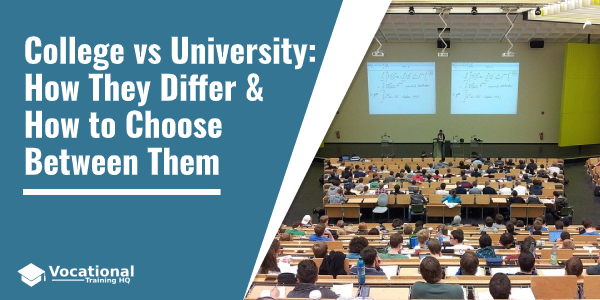Lots of high school students face the problem of choosing between a college and a university.
As these terms are often interchangeable, most people have hardships trying to explain the difference.
In most cases, college is used as a general term for the description of any higher-education facility.
Nevertheless, there are numerous differences between colleges and universities, and various types of colleges can be identified.
In order to make the right decision, you need to understand the difference between these notions of property.
When it comes to education, both colleges and universities offer broad-based training required for the development of a wide range of professional skills.
Pretty often, these educational facilities use a theoretical approach focusing on the way of thinking.
After such programs, students can start one of the numerous careers in the field they are interested in.
After that, lots of students decide to get some extra training in order to get better career prospects.
So, it is time to learn about the differences between colleges and universities.
First of all, colleges provide only undergraduate education while universities have both undergraduate and graduate programs.
Of course, there can be some exceptions but they are not common.
There are lots of facilities that are known as colleges that offer graduate programs.
The list includes such famous facilities as Dartmouth College, Boston College, The College of William and Mary, and others.
Speaking of colleges, there is a whole variety of them including career colleges, community colleges, liberal arts colleges, and others.
Considering an incredible amount of options, it is a real challenge to choose an educational facility that suits your needs.
If you want to learn about the issue so you can the right choice, keep reading this article as there’s everything you should know about the difference between colleges and universities.
Article Table of Contents
What Is a University?
If you want to identify a university, it can be described as an institution that grants students a degree.
In contrast to colleges, universities offer graduate programs that allow obtaining master’s or doctoral degrees.
Also, in comparison to colleges, universities are larger and have a wider range of programs and courses.
The most confusing thing is that lots of universities consist of different colleges and schools.
For example, Harvard College is a part of Harvard University that offers undergraduate programs in liberal arts.
The University itself includes about 10 professional and graduate schools such as Harvard Business School, Harvard Law School, Harvard Medical School, and others.
Among other universities that consist of several colleges, there is Purdue University which has 10 schools and colleges.
The list includes the College of Engineering and the College of Veterinary Medicine.
As a part of the university, all these colleges can provide students with a graduate degree diploma.
Public vs. Private
There are two types of universities – public and private.
The first ones are those founded by the state and local government, and each state should have at least one public university.
In-state students can expect lower fees when applying for a program at a public university.
The reason is that in-state residents support public educational facilities by paying taxes.
When it comes to private universities, they are not supported by the government.
The only source of their funding is tuition fees, private donations, and endowments.
As a result, private universities have higher fees than public ones but lots of them offer various types of financial aid.
Research vs. Teaching Universities
Any university pays attention not only to the teaching but to the research as well.
The balance between these two aspects varies from one university to another.
Usually, universities that are focused on research, are bigger, and have more students.
Also, these universities offer a wider range of majors and training courses for undergraduate and graduate levels.
Moreover, these universities are full of well-equipped state-of-the-art facilities such as libraries and labs.
Finally, most faculty members are commonly-recognized experts in their fields of interest.
Unfortunately, most students don’t have an opportunity to communicate with these specialists because most undergraduate classes are held by teaching assistants instead of professors.
Moreover, these classes are usually attended by hundreds of students so they are very big and held in spacy lecture halls.
As you understand, it can be hard to interact with these specialists in person.
Speaking of teaching universities, their main goal is to provide students with the required knowledge.
Professors tend to have packed schedules full of classes and do not need to worry about publish-or-perish aspects.
Of course, professors can conduct various research but classes are their main responsibility.
Finally, while these universities do not have numerous upscale facilities, students can communicate with their professors as much as they need.
What Is a College?
The word “college” has a whole variety of meanings.
It may mean an institution that is similar to a university and grants students a degree.
One other meaning is a school that offers short-term courses focused on specific careers.
Below, you can find information about various types of colleges and their specifics.
Career College
Career colleges are also known as tech or vocational schools that offer job-oriented courses that aim to prepare students for certain careers.
These facilities can provide you with diplomas, certificates, or associate’s degrees that can be obtained in a couple of years.
Some of them can also provide students with a bachelor’s degree that can be obtained in 3-4 years of full-time training.
Sometimes, these colleges consider themselves as universities despite the fact they do not have all the same features traditional universities have.
Speaking of available programs, there is a wide range of options including health care, business, design, dental hygiene, information technology, culinary arts, cosmetology, aviation maintenance, HVAC repair, and many others.
Community Colleges
Community colleges are also known as junior colleges and they offer associate’s degrees and sometimes certificate programs.
Usually, these programs can be easily completed in only two years.
You need to know that community colleges are pretty small and offer lots of interaction with faculty representatives and instructors.
In most cases, you can enter a community college with just a high-school diploma or GED certificate as these colleges have open admission.
Lots of students prefer to apply for two-year courses and after completing it, enroll in a bachelor’s degree program at a university.
The reason is that community colleges have lower tuition fees than four-year institutions.
An average annual fee at a two-year college is about $3 660 while applying for a four-year program, you should be able to pay about $10 230 per year.
Liberal Arts Colleges
Four-year colleges are known as liberal arts colleges that offer undergraduate programs.
As there are no or only graduate programs, liberal arts colleges are focused on teaching instead of research.
Most programs provide general education that is focused on the development of problem-solving, critical thinking, and communication skills.
Among the available programs, there are those focused on literature, history, languages, math, and life sciences.
There are no professional programs such as ones in medicine and engineering.
Also, there is a smaller variety of majors in comparison to universities.
Some liberal arts colleges are a part of big universities while others are stand-alone educational facilities.
The first ones are usually rather small with a very high faculty-to-student ratio.
One other significant point is that it is a full-time faculty that holds classes instead of teaching assistants.
There are only a few public liberal arts colleges and most of them are private.
Finally, almost all graduates tend to continue their education by applying for master’s or doctoral degrees provided by universities.
How to Choose the Best Type of Educational Institution?
Usually, it is very hard to decide whether to choose a college or university.
There are so many educational options that range in length and specifications that it can be stressful and challenging to make the final decision.
To make this experience easier for you, we’ve prepared a step-by-step guide with useful tips.
Determine Your Career Goals
The first thing you should pay attention to is your plans for the future.
You need to determine what career you want to pursue and what kind of training will help you achieve your goal.
If you want to start working as soon as possible and aim to get all the essential skills, you should give preference to career colleges.
In order to save money while pursuing a bachelor’s degree, start with a community college, and then continue your training at a four-year university.
A four-year educational facility is perfect for those who are still unsettled about a certain career or want to obtain a general education suitable for various careers.
Evaluate Your Academic Record
Each college and university has its own admission requirements including a certain level of academic achievement.
Make sure to learn the requirements of colleges you are interested in, evaluate your grades, and check whether they meet the criteria.
Keep in mind that the more popular a college or university is, the fiercer competition for spots you can expect.
The exception is career and community colleges that have no admission requirements so anyone with a high-school diploma can enroll in one of the training programs.
It is a perfect option for students with rather low grades.
Also, it can be a safe bet for students interested in bachelor’s degrees while having low grades.
After completing a training course at a community college, you can easily enter a four-year university to obtain a degree.
Decide on Your Learning Style
There are several aspects that may influence an overall learning experience and the size of classes is one of them.
When it comes to universities, classes there are really huge, especially during the first years.
Some lectures can be even attended by hundreds of students simultaneously.
At the same time, colleges tend to have small classes attended by 20-30 students.
If you want to interact with your teachers as much as possible, you should consider getting your training at a college or a vocational school.
Just keep in mind that colleges offer fewer opportunities for students interested in research.
If you prefer a self-directed way of studying and want to interact with the best specialists in your sphere of interest, a research university program is the best option for you.
Decide What College Experience You Expect
If you are one of those students who dream about living in a dorm during their college years, you should opt for four-year institutions.
Just keep in mind that most two-year institutions do not have any dorm or other housing options.
If you feel like a campus life is exactly what you need, give preference to four-year universities and colleges.
If you are not interested in campus life and only try to fit your education into your daily routine, you should consider applying for a program at a career or community college.
They are popular among the commuter crowd so their schedule can be easily incorporated into your daily life.
Programs at community colleges tend to be more flexible.
Also, there’s even a possibility to get trained online.
One other important aspect is the various extracurricular activities.
If you are interested in various clubs and out-of-classroom events, you need to remember that colleges aren’t the best option.
As there is no campus life, extra activities are pretty rare.
At the same time, as a student of a four-year institution, you have an opportunity to enjoy a whole variety of different events and activities.
Another factor in the college experience is extracurricular activities.
The list of activities includes college newspapers, clubs, professional associations, outings, parties, getaways, and even game nights.
Also, consider applying for a four-year university, if you are interested in fraternities, sororities, or high-profile athletics.
Assess Your Financial Situation
The type of college you are going to choose significantly depends on your financial situation and paying ability.
Universities are pretty expensive so if you have a very tight budget, you should opt for a two-year program.
Tuition fees significantly vary from one college to another.
Below are some statistics on tuition fees in various types of educational facilities:
- Public two-year college—$3,660
- Public four-year college—$10,230
- Public four-year college—$26,290
- Private four-year college—$35,830
Just keep in mind that these are some basic rates while numerous colleges can provide you with some financial aid.
7 Tips for Transferring From a 2-Year to a 4-Year Institution
Lots of students aiming for a bachelor’s degree decided to start with a two-year program at a community college.
According to the data, about 50%of students prefer to start with college training and then transfer to a four-year program.
It is a perfect option for those who want to reduce tuition fees, improve their records, or be able to combine their education with daily life.
If you are interested in this path, you should that there are a bunch of tips that can significantly help you.
Below, you can find some of the most useful tips on how to transfer from a two-year to a four-year program.
1. Plan in Advance
To make sure your transfer is successful, you need to plan it as soon as possible and ideally, you should do it even before you graduate high school.
Most states have articulation agreements that list the courses required for the transfer from one program to another.
Just keep in mind that these agreements are relevant for a certain state and the same majors.
If you decide to move to another state or simply change your major, it is more likely you won’t be eligible to transfer your credits.
Just make sure to learn all the requirements beforehand.
2. Obtain an Associate Degree before a Transfer
According to recent studies, more than 72% of transferred students were able to get a bachelor’s degree after completing a two-year program.
At the same time, only 56% of students got a bachelor’s degree without obtaining an associate’s degree.
In other words, a completed associate’s degree can guarantee you a higher success rate while pursuing a bachelor’s degree.
3. Develop Relationships with College Advisors
Try to stay in touch with advisors of colleges you are interested in in order to learn about available courses and possibilities for transferring.
Addressing advisors, you will get info about courses that will let you transfer to the bachelor’s program in the future.
Also, advisors may have some useful tips that will make your transfer easier faster, and smoother.
4. Learn Admission Requirements
The first aspect you should pay attention to when transferring is your academic success rate.
Most colleges take into consideration a grade point average (GPA) and grades in transferable courses when accepting a transfer student.
If you want to transfer successfully, make sure to learn the requirements of the school you are interested in beforehand.
Some students can transfer to a four-year college or university but they are not admitted to the program they are interested in.
The reason is that each program within an educational facility can have specific requirements so make sure to learn all the available information.
Don’t forget to learn about the required admissions materials or deadlines.
5. Learn about Scholarships for Transfer Students
The number of scholarships increases constantly including the number of options for transfer students.
For example, there is a scholarship of $40,000 for transfer students offered by the Jack Kent Cooke Foundation annually.
Considering the fact that the number of transfer students is smaller than the overall number of students, you can easily get a good amount of financial aid.
6. Consider living on Campus
While it can be stressful to start your campus life, it may help you to integrate into your student life faster and smoother.
It will let you enroll in a bigger variety of extracurricular activities while living on campus.
Also, it is a good chance to create bonds with other students.
7. Be Ready to Work Hard
Most people tend to think that a community college has low academic standards but it is not the truth anymore.
The truth is that nowadays community colleges have as hard schedules and classes as universities may have.
Your grades from a community college will be very important when it comes to transferring so make sure to work hard and study well.
Types of Programs That Allow Transfers
The list of majors that allow transfer is pretty big but it usually varies from one college to another.
There are several majors that have standard articulation agreements for a transfer from an associate degree to a bachelor’s degree.
The list of majors includes options such as:
- Agriculture
- Business Administration, Management, and Marketing
- Criminal Justice
- Psychology
- Nursing
- Healthcare Administration
- Biology
- Economics
- Education
- Engineering
- Environment and Conservation
- Communications
- Political Science
- Computer and Information Sciences
- Hotel Management
- Real Estate
- Security
- Transportation
Map Out Your Future
A choice between a college and a university can become a real challenge for most students.
Following our tips, you will be able to make the right choice and get the education you need.
Just make sure to do good research and learn about all colleges and universities that may suit your needs.





